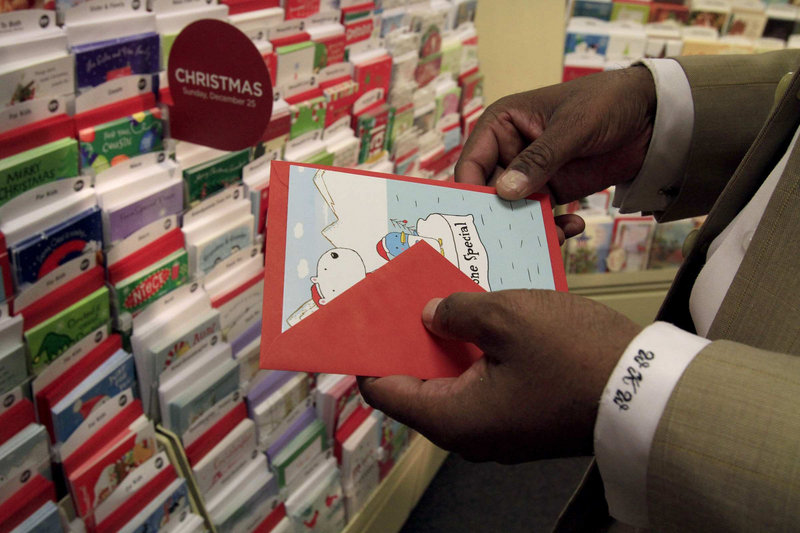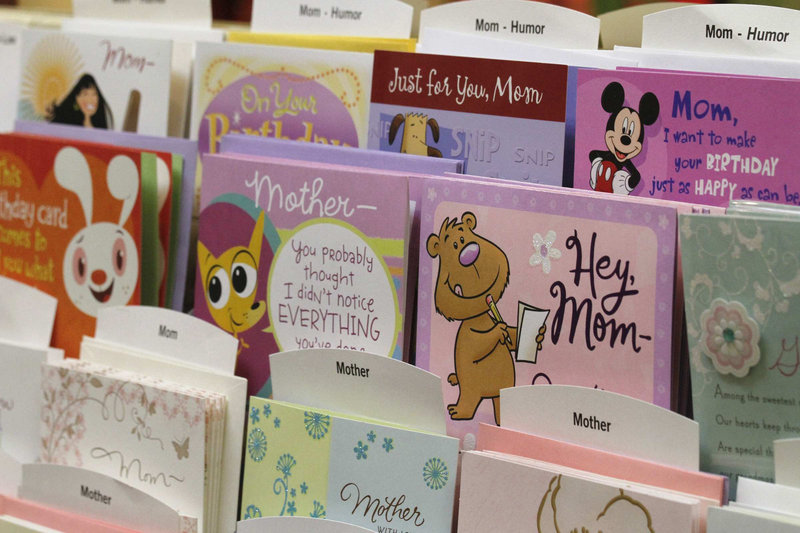The greeting card business may be in need of a get-better-soon card.
In the Internet age, with electronic greetings of all kinds now available, sales of traditional greeting cards have been on a long, gradual decline. In 1995, the national Greeting Card Association boasted that 2.7 billion Christmas holiday cards would be sold that year. This year, that number has dropped to 1.5 billion cards.
Even so, greeting card makers say don’t count them out. The industry estimates overall sales of 7 billion greeting cards this year. New lines of cards and new products are being introduced every year, and the industry’s second-largest card publisher, American Greetings Corp., has turned around sales in the last two quarters after a long decline. (Industry leader Hallmark Cards Inc. does not make its sales and profit public.)
“Even with the boom of social media, the death of the traditional greeting card has been vastly exaggerated,” said Susan January, president of the Greeting Card Association.
Consumers themselves are split. Five years ago, Sharon Matthew stopped sending the 25 holiday cards she sent out every winter and switched to sending Christmas messages by email.
“It’s just better,” said Matthew, 38, who was shopping at the Grove shopping center in Los Angeles. “My friends are all over the world. It’s easier to send them this way — you can attach more than one photo, give a little update on what’s going on.”
But not everyone feels that way. Elizabeth Escamilla, 45, still sends about 100 cards every Christmas. “It’s that one time of the year to write something personal, extra meaningful.”
“I still like receiving cards, so I like sending them,” said Carrie Rollings, 45, a real estate agent from Santa Monica, Calif. “It’s becoming more unusual, so it’s now more unique. It’s nice to open something in the mail that’s not a bill.”
Experts attribute the card sales decline to increasing competition from e-cards and custom card services, as well as more modern, and time-efficient, ways of communication.
“The industry’s been really, really suffering from social media and email and the whole ability of their customers to connect with people they typically connect with by sending greeting cards,” said Kathleen Ripley, industry analyst at IBISWorld Inc.
Retail greeting cards is a $7.5 billion business these days, the Greeting Card Association estimated. There are more than 3,000 greeting card publishers in the U.S., with the two largest companies — Hallmark and American Greetings — holding 82 percent of the market share, according to IBISWorld.
Like other nonessential consumer products, greeting cards felt the effect of the recession, but January of the greeting card association said that the industry is fairly recession-proof.
“Because our products have such a low price threshold,” she said, “we didn’t experience the total sales crash-and-burn other luxury items may have had.”
Greeting card prices range from 49 cents to $10.
“As better products have become available,” January said, “people are more aware how certain embellishments, like gold foil and embroidery, increase the perceived value of the card and the perceived value of their relationship.”
“There has not been any shift away from ink-on-paper greeting cards,” said Jacyln Twidwell, spokeswoman for Hallmark, based in Kansas City, Mo., “just an overall broadening of the greeting card portfolio we offer to our customers.”
Twidwell said Hallmark’s research found that more than 20 paper cards are still sent for every e-card.
“Our observation is that electronic communication is better for sharing information,” she said, “but greeting cards are better for sharing emotion.”
Hallmark has expanded its card selection and features, adding niche cards in categories that include godchildren, school bus drivers and hairdressers. It’s all about staying relevant, Twidwell said. The company also has new 3-D cards, more cards with sound and even holiday cards with lights that pulse to the beat of the music.
American Greetings is taking on similar challenges in an ever-changing marketplace. The Cleveland company last quarter reported profit, including a one-time gain, of $14.5 million, or 35 cents a share, up 71 percent from a year earlier. Sales rose 7 percent to $369 million.
The company is reaching out to younger customers. (The median age of American Greetings consumers is 46, according to IBISWorld.) It said it is keeping up with multimedia features, updating its holiday digital slide show cards — paper cards holding LCD screens that display personal photos uploaded by the sender. And it launched its justWink line in June. These cards come with codes that, scanned by a smartphone, lead to an online app that enables customers to create virtual greeting cards.
“It’s unique,” American Greetings spokesman Frank Cirillo said. “It meets a need that we saw in the consumers that shop our categories. It’s a new way to make meaningful and fun connections.”
Send questions/comments to the editors.




Success. Please wait for the page to reload. If the page does not reload within 5 seconds, please refresh the page.
Enter your email and password to access comments.
Hi, to comment on stories you must . This profile is in addition to your subscription and website login.
Already have a commenting profile? .
Invalid username/password.
Please check your email to confirm and complete your registration.
Only subscribers are eligible to post comments. Please subscribe or login first for digital access. Here’s why.
Use the form below to reset your password. When you've submitted your account email, we will send an email with a reset code.